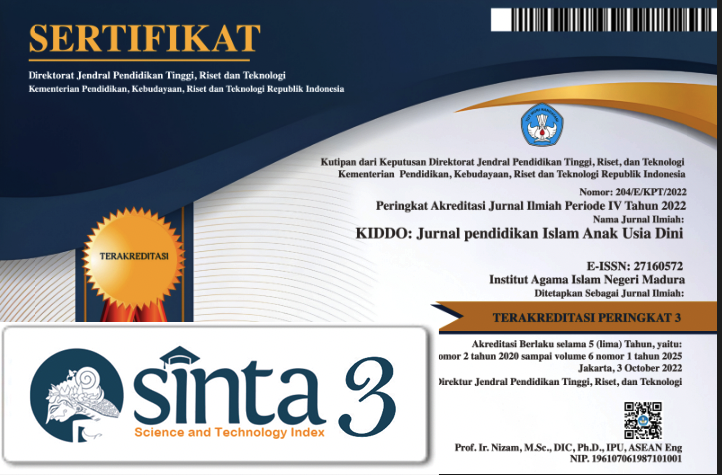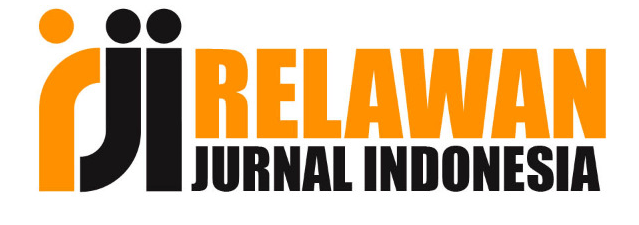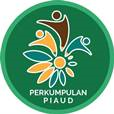Pendidikan Anak Usia Dini dalam Perkembangan Tekhnologi: Peran Kurikulum Ramah Anak dan Literasi Artificial Intelligence
 Abstract views: 231
,
Abstract views: 231
,
 PDF downloads: 116
PDF downloads: 116
Abstract
Abstract
Early childhood learning (PAUD) is an important stage in forming the foundations of child development. However, in an era where technology is developing rapidly, the challenges for the quality of early childhood learning are increasingly complex. This article proposes a strategy to improve the quality of PAUD learning by paying attention to technological developments, especially artificial intelligence (AI) literacy, as well as implementing a child-friendly curriculum. Through library research using a content analysis approach, this research reveals that The role of a child-friendly curriculum is to ensure that the learning process is appropriate to the needs and developmental stages of early childhood. This curriculum does not only focus on academic aspects, but also integrates social, emotional learning and relevant life skills. Apart from that, AI literacy is an important aspect in the context of future learning. Children need to be introduced to basic concepts about artificial intelligence and related technologies, so that they can become intelligent and critical users in facing future technological challenges. Effective early childhood education must be able to accommodate the dynamics of current technology while still paying attention to the child's overall needs and development stages.
Downloads
References
CHILD-FRIENDLY EDUCATION (2012)Transforming the lives of children affected by climate change https://www.unicef.org/documents/child-friendly-schools-manual United Nations Children’s Fund (UNICEF) New York, NY 10017, USA June.
Dewey, J. (1902) Anak dan kurikulum. Chicago: University of Chicago Press 12. Bobbitt, F. 1918. Kurikulum. Boston: Houghton Mifflin
Jiahong Su dkk (2023), Artificial Intelligence (AI) Literacy in Early Childhood Education: The Challenges and Opportunities, Computers and Education: Artificial Intelligence , 4 100124. 3
Kewalramani, S., Palaiologou, I., Dardanou, M., Allen, K. A., & Phillipson, S. (2021). Using robotic toys in early childhood education to support children’s social and emotional competencies. Australasian Journal of Early Childhood, 46(4), 355
Kusumaningrum , (2018), Implementasi Teknologi dalam Pengembangan Kurikulum Ramah Anak di lembaga pendidikan anak usia dini. Jurnal Teknologi Pendidikan.
Mestika Zed, (2008), Metode penelitian Kepustakaan , Jawa Barat. Yayasan Obor Indonesia,
Misnatun, (2017), Pola Pembentukan Karakter Anak Melalui Pendidikan Ramah Anak dalam Perspektif Pendidikan Islam. Tasyri‟, 24(1).
Permendikbud. (2014). Peraturan Menteri Pendidikan dan Kebudayaan Republik Indonesia No. 137 Tahun 2014 Tentang Standar Nasional Pendidikan Anak Usia Dini. http://repositori.kemdikbud.go.id/12860/. (diakses 03/01/2024)
Rahmawati, Anayanti (2022), The Concept of Child-Friendly Early Childhood Curriculum Development in Early Childhood Education, Proceedings of the 6th International Conference on Learning Innovation and Quality Education ICLIQE Advances in Social Science, Education and Humanities Research.
Ratna Rahmawati,(2023) Model Sekolah PAUD Ramah Anak Berbasis Islam di Kecamatan Songkohor Aceh Singkil, Skripsi, UIN Ar-Raniry Darussalam Banda Aceh, 15.
Rismayani. (2020), Analisis Pendidikan Ramah Anak Pada Lembaga Pendidikan Anak Usia Dini di Kecamatan Majauleng Kabupaten Wajo, Skripsi, UIN Alauddin Makassar.
Sri Hidayati, (2021), Strategi Pembelajaran Anak Usia Dini, Surabaya. Kanaka,
Su, J., & Zhong, Y. (2022). Artificial intelligence (AI) in early childhood education: Curriculum design and future directions. Computers & Education: Artificial Intelligence, Article 100072.
Yulianto, (2016).Pendidikan Ramah Anak Studi Kasus SDIT Nur Hidayah Surakarta. Kajian Kependidikan Islam, 1(2).
Yumnah, Siti (2022). Sekolah Ramah Anak Kajian Teori dan Praktik, (Malang: CV Literasi Nusantara Abadi.
Copyright (c) 2024 Nurul Qomariyah Nurul Qomariyah

This work is licensed under a Creative Commons Attribution 4.0 International License.
-
The journal operates an Open Access policy under a Creative Commons 4.0 International license. The terms of the license are:
Share— copy and redistribute the material in any medium or format
Adapt— remix, transform, and build upon the material for any purpose, even commercially.
1. Authors retain copyright and grant the journal right of first publication with the work simultaneously licensed under a Creative Commons License.that allows others to share the work with an acknowledgement of the work’s authorship and initial publication in this journal
2. Authors are permitted and encouraged to post their work online (e.g., in institutional repositories or on their website) prior to and during the submission process, as it can lead to productive exchanges, as well as earlier and greater citation of published work (See The Effect of Open Access).
Jurnal Kiddo is licensed under a Creative Commons
n Access).














